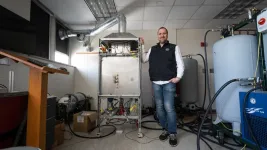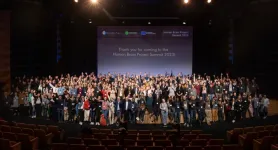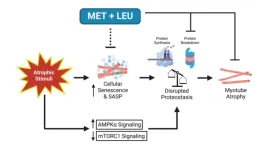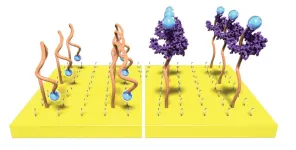(Press-News.org) Pawel Olszewski, a University of Wisconsin Oshkosh associate mechanical engineering technology professor, recently was granted a U.S. patent for his flameless impingement oven, designed and built in the Teaching and Energy Research Industrial Lab (TERIL) on the Oshkosh campus.
Olszewski began the patent process back in 2019 with WiSys, the Wisconsin-based nonprofit dedicated to helping inventors protect their intellectual property, and received the news of approval in February.
Titled “flameless impingement oven,” the invention is patent number US 11,585,601 B2, granted on Feb. 21.
Industrial ovens—like the ones this creation improves upon—are used for a variety of purposes, including heat treating and melting materials like steel or aluminum. The benefits of the flameless impingement setup, Olszewski said, include faster heating to increase productivity; fewer emitted pollutants because the thorough heating reduces nitrogen oxides; and a reduction in fuel consumption with gases exhausted at lower temperatures.
The new oven arranges natural gas and air jets to directly affect the object being heated, substantially transferring heat by impingement transfer rather than by conventional radiation and thermally induced convection.
Because the air and gas are swirling at such speeds inside the oven—“like a huge tornado,” Olszewski explained—the chemical reaction to produce extreme heat is occurring everywhere all the time.
The chamber, which is a foot tall, a foot wide and a food deep, reaches temperatures beyond 1,800 degrees Fahrenheit.
“Everything mixes and the gas is always meeting the oxidizer,” he said. “So when you look inside the furnace during the normal flameless operation, there are no flames. You have combustion but no flames. Natural gas oxidizes, it reacts with the oxygen, generates heat, but there is no flame.”
The prototype was built in the TERIL on the third floor of the Halsey Science Center. The oven is the fourth unique industrial system built there and requires the other three to run: chilling, pumping and compressed air.
The idea can be traced back to when Olszewski was a post-doctorate fellow at the University of Michigan. While there, he worked with simpler flameless ovens. The ideas continued to swirl around in his mind and when he came to UW Oshkosh in 2014 he and his students began to create all of the industrial systems that allowed for the oven to exist.
“There is no single piece of the equipment that was purchased in the state it’s in. Everything was purchased as a component,” he said. “We cut whatever the frames, we organized our own control cabinets, everything here including the software that controls all of the systems.”
What Olszewski is hoping for next is a local company to express interest so the idea can grow beyond the single prototype. He said any company that melts aluminum, cast iron, steel or even glass could make use of the technology. It can translate to more or less any size and ovens already in use could be retrofitted.
“I’m hoping it will catch somewhere,” he said.
-30-
UW Oshkosh is home to 9,703 undergraduate, graduate and doctoral students on three campuses. With more than 250 majors, minors and certificate programs, UW Oshkosh offers one of the largest program arrays in Wisconsin. Student success is at the heart of UW Oshkosh. Students benefit from personalized support with small class sizes, a wealth of academic and personal support services, and personalized career and academic advising. Oshkosh is ranked as the No. 1 best college town and the No. 4 most livable small city in the United States, and students benefit from entertainment, employment and recreation of a thriving community. With a strong research focus and national ranking in sustainability, Titans demonstrate on a daily basis what students can do to change the world. Learn more at uwosh.edu.
END
A new study from a Washington University researcher offers fresh insights into how the brain goes to great lengths to processes and remember everyday events.
Zachariah Reagh, an assistant professor of psychological and brain sciences in Arts & Sciences at Washington University in St. Louis, and co-author Charan Ranganath of the University of California, Davis, used functional MRI scanners to monitor the brains of subjects watching short videos of scenes that could have come from real life. These included men and women working ...
**Note: the release below is a special early release from the European Congress of Clinical Microbiology & Infectious Diseases (ECCMID 2023, Copenhagen, 15-18 April). Please credit the conference if you use this story**
Embargo: 2301H UK time Friday 31 March
**Note – the press release is available in Spanish and Portuguese, see links below**
A 3-year-old girl was infected with an unusual Mycobacterium marinum infection, that developed following an iguana bite while she was on holiday in Costa Rica, report the doctors who treated her ...
Study Title: Belzutifan plus cabozantinib for patients with advanced clear cell renal cell carcinoma previously treated with immunotherapy: an open-label, single-arm, phase 2 study
Publication: The Lancet Oncology, March 31, 2023, 6:30pm ET, https://www.thelancet.com/journals/lanonc/article/PIIS1470-2045(23)00097-9/fulltext
Dana-Farber Cancer Institute author: Toni K. Choueiri, MD
Summary:
Immunotherapies, such as anti-PD-1 and anti-PD-L1, have become standard first line therapies for patients with advanced renal cell carcinoma (kidney cancer). Most patients, however, eventually experience disease progression, with no consensus on what therapy to use next. In this ...
The ten-year European Flagship Human Brain Project (HBP) links brain research with computing and technology in a large-scale, interdisciplinary approach. During the HBP Summit, researchers presented the abundant scientific achievements of the project and the legacy that it will leave for the research community. With the project approaching its conclusion in September 2023, a focal point of the final HBP Summit in Marseille was the discussion of the future of digital brain research.
One of the lasting contributions of the project is the research infrastructure EBRAINS, which provides open access to advanced technologies, tools, data and services for brain research and will ...
“Cellular senescence and disrupted proteostasis induced by myotube atrophy are prevented with low-dose metformin and leucine cocktail.”
BUFFALO, NY- March 31, 2023 – A new research paper was published on the cover of Aging (listed by MEDLINE/PubMed as "Aging (Albany NY)" and "Aging-US" by Web of Science) Volume 15, Issue 6, entitled, “Cellular senescence and disrupted proteostasis induced by myotube atrophy are prevented with low-dose metformin and leucine cocktail.”
Aging coincides with the accumulation of senescent cells within skeletal muscle that produce inflammatory products, known as the senescence-associated secretory ...
Molecules in our body send faint biochemical signals when health issues arise
New technology boosts these signals by 1,000 times
New approach paves way for sensing signals in real-time in the body without sending blood or saliva samples to a lab
EVANSTON, Ill. — The molecules in our bodies are in constant communication. Some of these molecules provide a biochemical fingerprint that could indicate how a wound is healing, whether or not a cancer treatment is working or that a virus has invaded the body. If we could sense these signals in ...
Half as many children in the United States were diagnosed with asthma in the first year of the COVID-19 pandemic compared to previous years, and Rutgers researchers think fewer colds may be part of the reason.
In a new Rutgers study, published in Respiratory Research, researchers examined the rates of new asthma diagnoses in a large commercial insurance claims database during the first year of the pandemic compared with rates of new diagnoses during the previous three years.
Using the Health Core Integrated Research ...
A common anesthesia drug could be beneficial in reducing pressure inside the skull of children with traumatic brain injuries (TBI), according to a study published in Critical Care Medicine.
Ketamine, a drug that has been used for anesthesia since the 1970s, has traditionally been avoided for patients with TBI due to early studies suggesting that it could raise the pressure inside of the skull, known as intracranial pressure (ICP).
More recent studies have suggested otherwise, said lead author Michael Wolf, MD, assistant professor of Pediatrics and Neurological ...
Photos
For the first time, researchers have pinpointed a date when elite Mongol Empire people were drinking yak milk, according to a study co-led by a University of Michigan researcher.
By analyzing proteins found within ancient dental calculus, an international team of researchers provides direct evidence for consumption of milk from multiple ruminants, including yak. In addition, they discovered milk and blood proteins associated with both horses and ruminants. The team's results are published in Communication Biology.
The study presents novel protein findings from an elite Mongol Era cemetery ...
URBANA, Ill. – For tiny salamanders squirming skin-to-soil, big-picture weather patterns may seem as far away as outer space. But for decades, scientists have mostly relied on free-air temperature data at large spatial scales to predict future salamander distributions under climate change. The outlook was dire for the mini ecosystem engineers, suggesting near elimination of habitat in crucial areas.
Now, University of Illinois researchers are tuning into the microclimates that really matter to the imperiled amphibians and forecasting a somewhat more hopeful future.
“The ...







